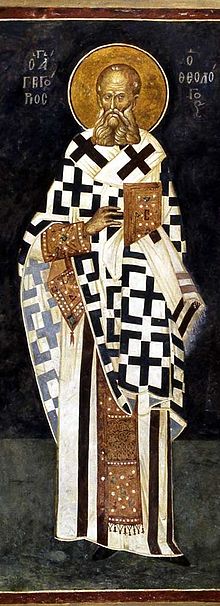Gregorios dari Nazianzus
Gregorios dari Nazianzus (Yunani: Γρηγόριος ὁ Ναζιανζηνός Grēgorios ho Nazianzēnos; sekitar. 329 M[1] – 25 Januari 389 atau 390[1]) - juga dikenali sebagai Gregorios si Ahli Teologi ataupun Gregorios Nazianzen - ialah seorang agamawan Kristian sekalu Uskup Agung Constantinople abad ke-4 M. Beliau dianggap penggaya retorik yang paling terampil pada zaman patria.[2]:xxi Beliau menerima pendidikan klasik sebagai seorang pemidato dan ahli falsafah, dan beliau menerapkan falsafah Yunani ke dalam gereja awal dan dengan itu mengasaskan paradigma buat ahli teologi Byzantine dan pegawai-pegawai gereja.[2]:xxiv

Fresko gambaran beliau dari Kariye Camii,
Istanbul, Turki.
Beliau menyumbang banyak terhadap teologi Tritunggal dalam kalangan kedua-dua ahli teologi yang berbahasa Yunani dan Latin, dan beliau dikenali sebagai "Ahli Teologi Triniti". Banyak karya teologinya masih mempengaruhi ahli teologi moden, terutamanya tentang hubungan di kalangan tiga Orang dalam Triniti (Persons of the Trinity). Beliau juga dikenali sebagai salah seorang Bapa Cappadocia, bersama-sama Basil Agung dan Gregory dari Nyssa.
Rujukan sunting
Bacaan lanjut sunting
- Michael Azkoul, "St. Gregory the Theologian: Poetry and Faith," Patristic and Byzantine Review 14.1–3 (1995): 59–68.
- Brian Daley, ed., Gregory Nazianzen. Early Church Fathers. London: Routledge, an imprint of Taylor & Francis Books, 2005. ISBN 0-415-12181-7, pp. 192.
- K. Demoen, "Biblical vs. Non-Biblical Vocabulary in Gregorius Nazianzenus; a Quantitative Approach," Informatique 2 (1988–89): 243–53.
- J. Egan, "Gregory of Nazianzus and the Logos Doctrine," J. Plevnic, ed., Word and Spirit: Essays in Honor of David Michael Stanley. Willowdale, ON: 1975. pp. 281–322.
- Anna-Stina Ellverson, The Dual Nature of Man: A Study in the Theological Anthropology of Gregory of Nazianzus. Acta Universitatis Upsaliensis, 1981. ISBN 91-554-1206-8. {Amazon.com}
- Gerald Fitzpatrick, "St Gregory Nazianzen: Education for Salvation," Patristic and Byzantine Review 10.1–2 (1991): 47–55.
- R.C. Gregg, Consolation Philosophy: Greek and Christian Paideia in Basil and the Two Gregories. Washington, DC: Catholic University of America Press, 1975. ISBN 0-8132-1000-3. {Amazon.com}
- Edward R. Hardy, ed. Christology of the Later Fathers, J. Baillie et al., eds. Library of Christian Classics, Vol. 3. Philadelphia: Westminster, 1995. Pbk. ISBN 0-664-24152-2
- Carol Harrison & Brian Daley (Editor). Gregory Nazianzen. Routledge, 1999. ISBN 0-415-12181-7
- V. Harrison, "Some Aspects of Saint Gregory (Nazianzen) the Theologian's Soteriology," Greek Orthodox Theological Review 34 (1989): 19–43/11–8.
- Susan R. Holman, "Healing the Social Leper in Gregory of Nyssa's and Gregory of Nazianzus's peri philoptochias," Harvard Theological Review 92.3 (1999): 283–309.
- M. Edmund Hussey,"The Theology of the Holy Spirit in the Writings of St. Gregory of Nazianzus," Diakonia 14.3 (1979): 224–233.
- George A. Kennedy, Greek Rhetoric Under Christian Emperors. Princeton: Princeton University Press, 1983. ISBN 0-691-03565-2. pp. 215–239. {Amazon.com}
- Vasiliki Limberis, ."'Religion' as the Cipher for Identity: The Cases of Emperor Julian, Libanius, and Gregory Nazianzus," Harvard Theological Review 93.4 (2000): 373–400.
- N.B. McLynn, "The Other Olympias: Gregory of Nazianzen and the Family of Vitalianus," ZAC 2 (1998): 227–46.
- Ruth Majercik, "A Reminiscence of the Chaldean Oracles at Gregory of Nazianzus, Or. 29,2," Vigiliae Christianae 52.3 (1998): 286–292.
- P.J. Maritz, "Logos Articulation in Gregory of Nazianzus," Acta Patristica et Byzantina 6 (1995): 99–108.
- E.P. Meijuring, "The Doctrine of the Will and the Trinity in the Orations of Gregory of Nazianzus," Nederlands Theologisch Tijdschrift 27.3 (1973): 224–34.
- Celica Milovanovic-Barham, "Gregory of Nazianzus: Ars Poetica (In suos versus: Carmen 2.1.39)," Journal of Early Christian Studies 5.4 (1997): 497–510.
- H. Musurillo, "The Poetry of Gregory of Nazianzus," Thought 45 (1970): 45–55.
- T.A. Noble, "Gregory Nazianzen's Use of Scripture in Defence of the Deity of the Spirit," Tyndale Bulletin 39 (1988): 101–23.
- F.W. Norris, "Of Thorns and Roses: The Logic of Belief in Gregory of Nazianzen," Church History, Vol. 53 (1984): 455–64.
- F.W. Norris, "The Tetragrammaton in Gregory Nazianzen (Or. 30.17)," Vigiliae Christianae 43 (1989): 339–44.
- F.W. Norris, Faith Gives Fullness to Reasoning: The Five Theological Orations of Gregory Nazianzen. Supplements to Vigiliae Christianae, Vol 13. Leiden: Brill, 1990. ISBN 90-04-09253-6. p. 314. {Amazon.com}
- Jay Wesley Richards, "Can a Male Savior Save Women?: Gregory of Nazianzus on the Logos' Assumption of Human Nature," Christian Scholar's Review 28.1 (1998): 42–57.
- K. Skurat, "St. Gregory of Nazianzus on Philosophy and Knowledge of God," Journal of Moscow Patriarchate 10 (October 1989): 57–62.
- Frank Thielman, "The Place of the Apocalypse in the Canon of St Gregory Nazianzen Diarkibkan 2011-07-06 di Wayback Machine," Tyndale Bulletin 49.1 (1998): 155–7.
- Steven Peter Tsichlis, "The Nature of Theology in the Theological Orations of St. Gregory Nazianzus," Diakonia 16.3 (1981): 238–46.
- Raymond Van Dam, "Self-Representation in the Will of Gregory of Nazianzus," Journal of Theological Studies 46.1 (1995): 118–48.
- Kenneth Paul Wesche, "The Union of God and Man in Jesus Christ in the Thought of Gregory of Nazianzus," St. Vladimir's Theological Quarterly 28.2 (1984): 83–98.
- Donald F. Winslow, "Gregory of Nazianzus and Love for the Poor," Anglican Theological Review 47 (1965): 348–59.
- Donald F. Winslow, The Dynamics of Salvation: A Study in Gregory of Nazianzus. Cambridge, MA: North American Patristic Society, 1979. ISBN 0-915646-06-4.
Pautan luar sunting
- Dalam bahasa Inggeris dan Yunani
- Links to English translations of works from Gr. of Nazianzus, website documentacatholicaomnia (Opera Omnia by Migne Patrologia Graeca with analytical indexes).
| Wikimedia Commons mempunyai media berkaitan Gregorios dari Nazianzus |
|
Wikisource mempunyai karya asli yang dikarang oleh atau mengenai: Gregory of Nazianzus |
| Wikisumber bahasa Yunani mempunyai teks asal berkaitan rencana ini: |
- Louvain-la-Neuve University hosts an important website NAZIANZOS devoted to the study of Gregory Nazianzene's works in Greek and other ancient languages.
- Greek texts with commentaries: Arthur James Mason, The five theological orations of Gregory of Nazianzus, Cambridge, 1899
- Unabridged audiobook at LibriVox
Jika anda melihat rencana yang menggunakan templat {{tunas}} ini, gantikanlah ia dengan templat tunas yang lebih spesifik.